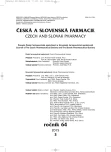The quality of life of patients suffering from the osteoporosis
Authors:
Lucia Masaryková; Magdaléna Fulmeková; Ľubica Lehocká; Tomáš Ďurdík
Authors‘ workplace:
Univerzitná lekáreÀ FaF UK, Bratislava, SR
; Farmaceutická fakulta, Katedra organizácie a riadenia farmácie a
; Farmaceutická fakulta, Katedra organizácie a riadenia farmácie
; Univerzita Komenského
; Univerzita Komenského
Published in:
Čes. slov. Farm., 2015; 64, 72-78
Category:
Original Articles
Overview
Osteoporosis (OP) is a systemic skeletal disease characterized by an imbalance of bone remodelling process due to the prevalence of osteoresorption over osteosynthesis. As a result of these changes, the decrease in bone mass and density occur followed by an increase in fracture risk1). Its clinical manifestation is initially asymptomatic but in the course of time it is quite the contrary – really severe (bone pain, movement disorders, fractures) with a lot of further adverse consequences, including death2). The presented study deals with the impact of osteoporosis and its consequences on the quality of life of patients. The research is focused on patients diagnosed with or treated for osteoporosis that is to say by non-uniform etiology. By questioning of the sample of 128 patients evaluating various dimensions of the patient’s quality of life (physical condition, mental state, and social status, overall satisfaction with life and health state) and tracking patients’ satisfaction with the therapy as well. By analysing the results, we found that osteoporosis affects the quality of life, especially physical state of health because up to 31.25% of patients say that they have suffered from every day’s backaches. It affects social life in the member of 7.81% patients, and 28.13% patients say that biggest problem with osteoporosis is the loss of free movement and possible fracture.
Key words:
osteoporosis • quality of life • pharmacotherapy • questionnaire survey • fractures
Sources
1. Šteňová E., Šteňo B., Baqi L. Možnosti prevencie a liečby primárnej osteoporózy v ambulancii lekára prvého kontaktu. Via pract. 2008; 5(1), 34–38.
2. Dusilová Sulková S. Nezastupitelná úloha vitaminu D v prevenci a léčbě osteoporózy. Prakt. lékáren. 2011; 7(2), 58–61.
3. Consensus Development Conference Diagnosis, prophylaxis, and treatment of osteoporosis. Am J Med. 1993; 94(6), 646–650.
4. World Health Organisation. Assessment of fracture risk and its application to screening for postmenopausal osteoporosis. Report of a WHO Study Group. World Health Organ Tech Rep Ser 843: 1–129
5. Kanis J. A., et al. European guidance for the diagnosis and management of osteoporosis in postmenopausal women. Osteopor. Int. 2008; 19(7), 1103–1104.
6. Nguyen T., Sambrook P., Kelly P., Jones G., Lord S., Freund J., Eisman J. Prediction of osteoporotic fractures by postural in stability and bone density. BMJ 1993; 307(6912), 1111–1115.
7. Čierny D., Killinger Z., Payer J. Farmakologická liečba osteoporózy. Via pract. 2008; 5(11), 462–464.
8. Švehlíková L., Heretik ml. A. Kvalita života – o čom to hovoríme?. Psychiatria – psychoterapia – psychosomatika 2008; 15(3), 194–198.
9. Hnilicová H., Bencko V. Kvalita života – vymezení pojmu a jeho význam pro medicínu a zdravotnictví. Prakt. Lék. 2005; 85(11), 656–660.
10. Virág Ľ. Používanie liekov a kvalita života pacientov. Farmaceutická fakulta UK v Bratislave, prednáška.
11. Tesař T., et al. Farmakoekonomika a hodnotenie kvality života pacientov. Via pract. 2008; 5(7/8), 332.
12. Jenšovský J. Prevence osteoporózy. Interní medicína 2010; 12(3), 163–166.
13. Masunari N., Fujiwara S. Impact factors of osteoporosis on health-related quality of life. In: Health-Related Quality of Life 2009; 1–30.
14. Lips P., van Schoor N. M. Quality of life in patients with osteoporosis. Osteoporos. Int. 2005; 16(5), 447–455.
15. Hopman W. M., et al. Prospectively measured 10-year changes in health-related quality of life and comparison with cross-sectional estimates in a population – based cohort of adult women and men. Quality of Life Research 2014.
16. Azimi P., Shahzadi S., Azhari S., Montazeri A. An outcome measure of functionality and quality of life in Iranian women with osteoporotic vertebral fractures: a validation study of the QUALEFFO-41. J Orthopaedic Science 2014; 19(6), 860–867.
17. Tomková S., Beličáková Z. Osteoporóza u mužov. Via pract. 2009; 6(9), 350–352.
18. Palacios S., Neyro J. L., Fernández De Cabo S., Chaves J., Rejas J. Impact of osteoporosis and bone fracture on health-related quality of life in postmenopausal women. Climacteric 2014; 17(1), 60–70.
19. Darbà J., et al. Disability-adjusted-life-years losses in postmenopausal women with osteoporosis: A burden of illness study Global health. BMC Public Health 2015; 15(1); Article number 324.
20. Johnell O., Kanis J. Epidemiology of osteoporotic fractures. Osteoporos. Int. 2005; 16 S3–S7.
21. Špániková B. Onkologický ústav sv. Alžbety, Heydukova 10, Bratislava. Terapia osteoporózy. Prednáška. Kurz NEOX Academy: Osteológia pre monitorov klinických štúdií, Bratislava, 24. 11. 2010.
22. Tomková S., et al. Therapeutic adherence to osteoporosis treatment. International Journal of Clinical Pharmacology and Therapeutics 2014; 52(8), 663–668.
23. Rossini M., et al. Determinants of adherence to osteoporosis treatment in clinical practice. Osteoporos. Int. 2006; 17(6), 914–992.
Labels
Pharmacy Clinical pharmacologyArticle was published in
Czech and Slovak Pharmacy

2015 Issue 3
Most read in this issue
- Enhancing of drug bioavailability using liquisolid system formulation
- The quality of life of patients suffering from the osteoporosis
-
Effectiveness of phytotherapy in supportive treatment of type 2 diabetes mellitus
II. Fenugreek (Trigonella foenum-graecum) -
Pharmaceutical history of capuchin monastery in Prague-Hradčan
Part II. Capuchin balsam (Balsamum capucinorum)
